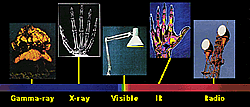
 |
| Visible light is only a part of the electromagnetic spectrum. By viewing the universe through different ranges of the electromagnetic spectrum, scientists have made many discoveries. When maps of the radio sky were first made, for example, quasars were discovered. The COBE satellite found evidence for the Big Bang Theory when mapping the microwave sky. We will be investigating these topics in future lessons, but first an introduction to the EM spectrum is necessary. Before you start, check out the Multiwavelength Milky Way. |
| ACTIVITIES on the Electromagnetic Spectrum |
Explore ancient Mayan astronomy, the electromagnetic spectrum and modern multiwavelength astronomy in this webquest. |
What is electromagnetic radiation? In what units is it measured? What are the different types? You will want a printout of this worksheet. For some questions you will also need to use the Spectrum Tuner applet which is a different version of the one whose link is on the worksheet. |
 |
Max Planck, a German physicist, found that certain behaviors of light could be predicted by considering it as though it were emitted in little bursts of energy rather than continuously. He developed a relationship in 1900 that gives the relationship between the energy and frequency of a photon (a quantum or packet of energy). In this worksheet, you will practice calculating energies, frequencies and wavelengths. |
|
Make a spectrum wheel to solve the mysteries. |
|
In this activity you will investigate the relationship between the wavelength and frequency of light and calculate time travels to various destinations in the universe via jet, rocket and sunbeam. |
|
Supplementary Activity 5 from the Hands-On Universe Book 4 (Measuring Size) p. 23-26 |
|
Read and answer the questions. |
 |
Color an x-ray image of the Hydra cluster of galaxies from the Chandra Observatory.
|
Make a innovative model giving information (wavelength, frequency, energy, etc) about the different types of electromagnetic radiation. You may make your model in the form of an Incan quipu, which is a model made from knotted rope (see example), or you may try EMR Pasta. Check the EMR Pasta Scoring Rubric for guidance. |
 |
|
References: Applet Spectrum HyperPhysics: The Electromagnetic Spectrum Imagine the Universe! The Electromagnetic Spectrum Ian Hickson's The Electromagnetic Spectrum |
|
| LAB IDEAS for the Electromagnetic Spectrum |
Recreate the experiment that led Sir Frederick William Herschel (1738-1822) to the discovery of infrared radiation.
|
 |
| PROJECT IDEAS for the Electromagnetic Spectrum |
 |
Build a model of the Chandra Observatory and write a paper detailing its mission and discoveries. |
Create framed museum portraits of Chandra images. Read the Scoring Rubric for guidance. |